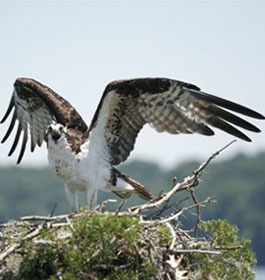


























|
 The magnification provided by this optical device allows one to observe specific details of a bird’s shape and coloration that cannot be seen otherwise. Often, one cannot correctly identify a bird without looking for such details. Additionally, binoculars allow intimate views into bird behavior and permit one to see a bird in the distance that would otherwise be scared off if approached. The magnification provided by this optical device allows one to observe specific details of a bird’s shape and coloration that cannot be seen otherwise. Often, one cannot correctly identify a bird without looking for such details. Additionally, binoculars allow intimate views into bird behavior and permit one to see a bird in the distance that would otherwise be scared off if approached.
A wide range of binoculars are available and can range in price from $10 to well over $1000; knowing what to look for will help you avoid an overwhelming shopping experience. The two most important characteristics of a pair of binoculars are the magnification and the size. The magnification describes how much larger an object appears when viewed through the binoculars compared to when viewed without binoculars. Thus, binoculars with a magnification power of 8 will make objects appear 8 times larger. Furthermore, the size of a pair of binoculars (which is given as the size of the larger, or objective, lens) is important as it determines two important attributes: light gathering ability and field of view. Large binoculars (i.e. binoculars with a large objective lens) let in more light than small binoculars. |
|
If you plan to use your binoculars in low-light conditions it’s important to have a large objective lens. Additionally, the size of the objective lens determines your field of view, or how much of a scene you will see through the binoculars. The larger your field of view, the easier it will be to locate a bird within a scene. The specifications for binoculars are listed as a pair of numbers, such as 8X42, where the first number describes the magnification power and the second describes the size of the objective lens. Generally, birder watchers use 7X35, 8X42, or 10X42 binoculars.
Other important factors to consider when purchasing binoculars are durability, weight, image quality, ergonomics, and focusing ability. If you have the opportunity, it’s helpful to compare multiple models side by side, ideally outdoors.
No matter how good your binoculars are, using them to watch birds ultimately depends on your abilities and techniques. Generally, binoculars aren't used to find birds. Rather, they are used to get a close up view of the details of a bird once it is spotted. You should scan the environment with your eyes and ears and only after you see movement or a familiar silhouette should you reach for the binoculars. It takes practice to spot an object and then quickly get the object in your binocular's field of view.
The key is to always keep looking at the bird; don't look away while reaching down for you binoculars and bringing them up to your eyes. With practice, you'll find that this helps to get the bird in your binocular's field of view very quickly. You may find that it's easier to first locate a more salient landmark (such as a distinctive part of a tree or a colorful piece of vegetation) next to the bird and then find it with your binoculars to focus in on the bird. With practice, you'll soon be able to have your binoculars focused in on a bird seconds after you first see it with your eyes only. |
|
Once you have spotted a bird with your binoculars and gotten a good look at its shape, coloration, and behavior, it’s now time to identify what species it is. This is accomplished using a field guide, a book that contains illustrations or photographs of all the birds found in a particular region. Additionally, most field guides provide valuable and interesting information regarding the distribution, habitat, and behaviors of each species. After observing a bird, the field guide should come right out as you begin comparing what you have seen to the birds listed in the guide. Field guides will tell you the specific telltale details to look for when identifying each species.
While many field guides are available and all contain similar information, there are some distinctions that you should know.
First, field guides either have illustrations or photographs of birds. For beginners, I recommend a field guide with illustrations. Although photographs offer the most realistic image of each species, they aren’t always perfect as the birds may be obscured by vegetation or shadows. Illustrations, however, allow the birds to always be presented in full view and in a typical posture. While photographs capture a single bird, illustrations provide an image of a perfectly stereotypical bird that highlights all the crucial details needed for identification. For these reasons, I believe illustrations are preferable to photographs. |
The other big difference you’ll quickly notice between field guides is the size of the geographic region they cover. You can find a field guide for all the birds of North America, for only the East or West Coast, for only a single state, or even for just a single county or park. The more specific your field guide is to your precise location the easier it will be to use to identify birds you see as the search process becomes much more streamlined. For example, if you’re identifying a bird in Georgia using a field guide that covers the entire continent, there will be a lot of birds you have to search through that don’t even occur in the state.
Thus, having a field guide exclusively for Georgia “prescreens” the birds as to only provide you with information about birds you have the potential to see. That said, there are benefits to a more general field guide covering a larger region. Although it may be heavier to carry and less efficient to search through, you’ll be able to use it across a larger geographic range. Also, it will have information on rare birds that don’t normally occur in your area but nevertheless may be present in small numbers.
Now it’s time to go out, get your binoculars and field guides, and hit the trails in search of all the fascinating birds here in Georgia. With these indispensible bird watching items, you’ll have the tools to observe birds up close noting every detail and the resources needed to determine the exact species you’re looking at. Be sure to come back and visit www.N-Georgia.com to read my upcoming article describing how to use a variety of bird feeders, birdbaths, and birdhouses to set up a private bird sanctuary right in your own backyard! Happy bird watching! |
| About the Author: Max Mehlman |
| I am a biologist pursuing a PhD examining avian neurobiology and behavior. I have conducted a wide variety of research projects ranging from cognitive and neurobiological laboratory studies to behavioral field experiments. As a writer for YourBirdOasis, a retailer of backyard birding supplies and an essential resource for burgeoning and expert birders alike, I have the exciting opportunity to share my knowledge of and passion for birds with many online communities. Visit http://www.yourbirdoasis.com for a huge selection of bird feeders, birdhouses, and everything else you'll need to set up your own backyard bird sanctuary! |
|
|
|
Check These Out:
 Backyard Birding Backyard Birding
 Trees and Shrubs for Attracting Birds Trees and Shrubs for Attracting Birds
 Birds of Georgia Birds of Georgia
|







